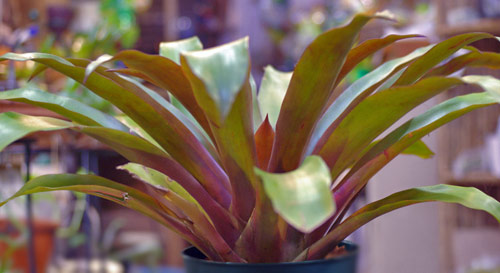 Tillandsia wagneriana (Now Barfussia)
Tillandsia wagneriana (Now Barfussia)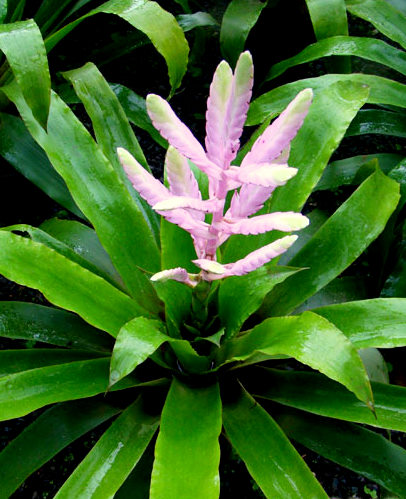
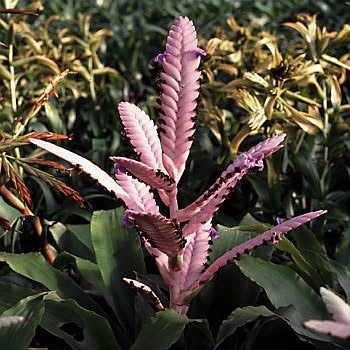
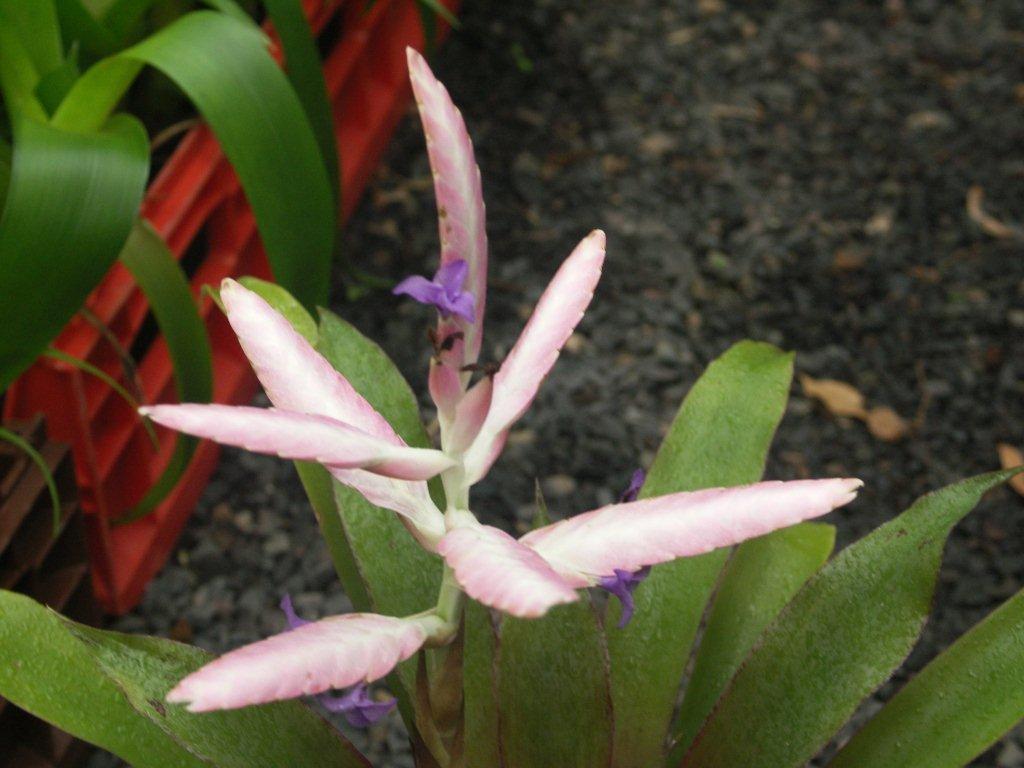
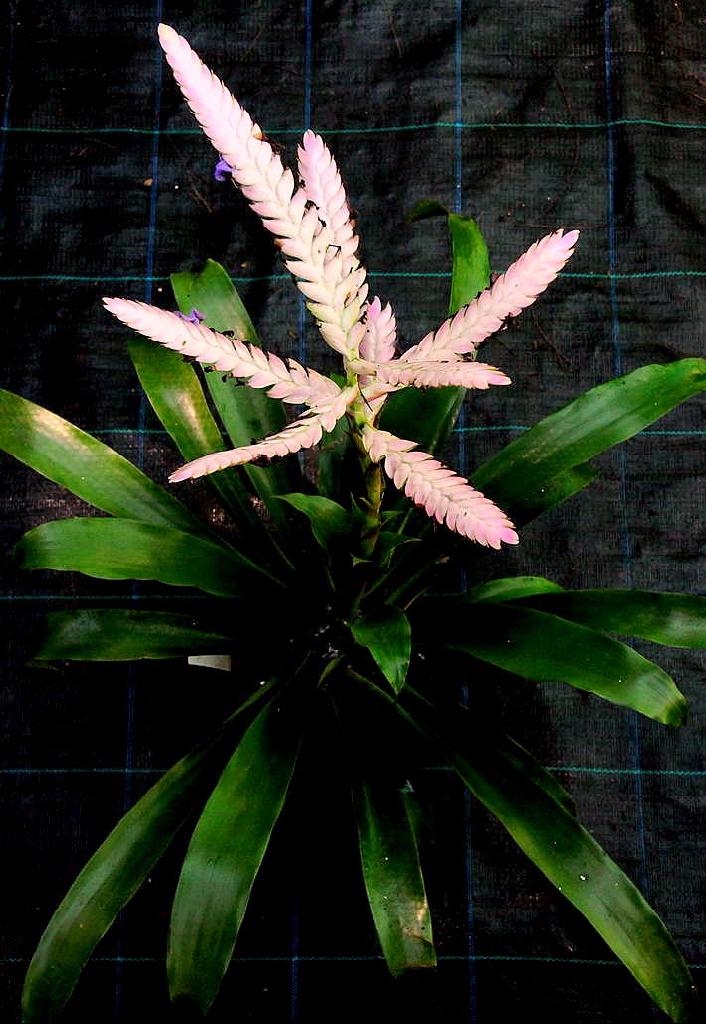
April 2011
 Tillandsia wagneriana (Now Barfussia)
Tillandsia wagneriana (Now Barfussia)




NEWS IN BRIEF . . .
NEW MEMBER:
MONTHLY RAFFLE PRIZE ROSTER:
A very warm welcome to Chris Butler and Anna Stewart and to Lydia and Ian Chinnock who joined at our February meeting. We wish them a long and happy association with our Society.
We will again be using the roster system for providing prizes for our monthly raffles. Bromeliads are preferred, but if you are unable to spare one then items such as potted herbs, cuttings, garden tools, etc. are acceptable. Also, if you are unable to attend the meeting—and/or are unable to supply a raffle prize when rostered—it would be appreciated if you would either ‘work a swap’ or speak to Elizabeth about getting a fill-in for your month. As our membership fees are kept very low, we rely on these raffles to help defray the costs involved in the running of our Society, and so your support is very necessary and very much appreciated.
| Carol Tieck, Barbara Jones-Beverstock, Gary Claydon, Christa Thomas, Colette Jackson | |
| Sandra Southwell, Christine Okoniowski, June Smith, Neville Wood | |
| Alexi Aleuras, Rhonda Patterson, Fred Burrows, Maria Jakobsen | |
| Jenny McKenzie, Phillip Robinson, Steven Dolbel, Jan Stammers | |
| Gino Di Cesare, Jenny Godin, John Carthew, Val Dixon | |
| Doreen Netting, Steve Morgan, Maadi McKenna, Vicki Joannou | |
| Glenise Weston, Warwick Varley, Ann Kennon, Eunice Spark | |
| Loreen Whiddett, Yvonne Perinotti, Meri Stefanidakis, Sharyn Baraldi |
COMING EVENTS:
| 16th AUSTRALASIAN BROMELIAD CONFERENCE - BROMS ON ARAFURA - For more details see below. | |
| ROYAL EASTER SHOW - HOMEBUSH | |
| Bromeliads Australia - Open Day. 49 Rutleys Rd, Wyee. 9am-4pm. 4359-3356/0418-471-754 | |
| 7TH COLLECTORS’ PLANT FAIR – “Woodgreen”, 25 Powells Road, BILPIN | |
| BROMELIAD SOCIETY OF NEW SOUTH WALES AUTUMN SHOW - Senior Citizens Centre, 9-11 Wellbank Street, CONCORD | |
| BROMELIAD SOCIETY OF AUSTRALIA AUTUMN SHOW – BURWOOD RSL | |
| CENTRAL COAST BROMELIAD SOCIETY SHOW - KARIONG | |
| ILLAWARRA BROMELIAD SOCIETY SHOW – Uniting Church Hall, Russell Street, CORRIMAL | |
| BROMELIAD SOCIETY OF AUSTRALIA SPRING SHOW - BURWOOD RSL | |
| BROMELIAD SOCIETY OF NEW SOUTH WALES SPRING SHOW - CONCORD |
MEETINGS:
PLANT RESULTS - February 5, 2011
OPEN
| Jørgen Jakobsen | Vriesea ‘Splenriet’ | |
| Jørgen Jakobsen | Neoregelia Fosperior ‘Perfection’ | |
| Chris Butler & Anna Stewart | Dyckia brevifolia (formerly D. sulphurea) | |
| John Carthew | Vriesea philippo-coburgii |
| Sandra Southwell | Vriesea ospinae | |
| Chris Butler & Anna Stewart | Nidularium ‘Ruby Lee’ | |
| Chris Butler & Anna Stewart | xNeophytum ‘Ralph Davis’ | |
| Laurie Dorfer | Vriesea ‘Barbara’ |
| Ann Kennon | leiboldiana | |
| Sandra Southwell | leiboldiana | |
| Chris Butler & Anna Stewart | leiboldiana var. guttata | |
| Chris Butler & Anna Stewart | fasciculata (Honduras) | |
| Sandra Southwell | brachycaulos (Guatemala) |
PLANT RESULTS - March 5, 2011
OPEN
| John Carthew | Vriesea ‘Kiwi Sunset’ | |
| Steve Morgan | Catopsis | |
| Suzanne Burrows | Vriesea philippo-coburgii |
| Carissa Morgan | Neoregelia ‘Enchantment’ | |
| Carissa Morgan | Neoregelia hybrid | |
| Steven Dolbel | Neoregelia hybrid | |
| Ann Kennon | Nidularium campos-portoi (formerly Wittrockia) | |
| Chris Butler | Aechmea ornata var. nationalis Verna | |
| Chris Butler | Neoregelia nivea | |
| Chris Butler | Neoregelia (carolinae X ‘Painted Lady’) X concentrica | |
| Noel Kennon | Nidularium rutilans |
| Freda Kennedy | ‘Creation’ | |
| Steve Morgan | stricta | |
| Laurie Dorfer | tectorum | |
| Sandra Southwell | cyanea | |
| Chris Butler | fasciculata (Purple) |
SOME NOTES ON TILLANDSIA WAGNERIANA
Some very interesting plants have already come to our competition tables this year, but when Laurie brought his pretty Tillandsia wagneriana to our February meeting it particularly caught my attention because ever since reading about this species when the Lee Moore article (reprinted on pp. 12-15 of this Newslink) was originally printed in our April 1997 Newslink, I had been fascinated by it.
In an article which appeared in the March/April 1979 edition of the Journal of The Bromeliad Society, Tillandsia wagneriana is described thus: “Exquisite is the term best used to describe this tillandsia with its delicate luminous pink inflorescence. Few tillandsias can surpass it in beauty. However, it is not for everyone, as it comes from the hot humid forests of Amazonian Peru and so is adapted only to greenhouse culture.” In another article, written by Professor Werner Rauh in 1970 (JBSI Vol. XX(3)), he describes it as being “One of the most spectacular tillandsias found within the last few years in Peru. … It is one of the green tillandsias and forms rosettes up to 40-50cm in diameter. The numerous leaves are lanceolate, about 45cm long, fresh green on the upper face and dull green on the lower face, frequently red-violet. From the centre of the rosette rises a branched inflorescence of a height of about 30-40 cm. This inflorescence is compound of 4-13 spreading spikes which have a length of about 10cm each and a breadth of up to 2cm. The most striking aspect of this plant is the colour of the bracts. They are bright pink. The colour of the floral bracts lasts about two months. In its vegetative state this plant does not need much light, but when the inflorescence is developing, more light will be necessary, otherwise the spikes will be only pale pink.”
By comparison, the ones we are seeing these days in Australia seem to be a little more cold tolerant than the original species (both Laurie and I have over-wintered our plants in shadehouses without any special attention to heating) but are only about half the size of those described above—both in height and in the number of leaves—and they tend more to have discolor leaves. When I queried this through the Till Nuts group, a suggestion was made that “The T. wagneriana you see on the market would have been originally selected for the European market and hence would have been selected on small plant/big flower! In any event it appears that if you grow discolor from seed you can get ordinary ones and discolor ones.”
GROWING TILLANDSIAS IN DIFFERENT SIZED POTS
By Eileen Killingly
After our March meeting I stopped off at a nursery on my way home and found, among some other discounted bromeliads, a Tillandsia flabellata. Not quite sure of its growing requirements I Googled and came up with a Web site (which turned out to be a Corn Bak related site [one of the major bromeliad-growing nurseries in Holland]) which stated: “Time of cultivation is 18-24 months in a 9cm pot. When grown in another size pot the time of cultivation is also different.”
This mention of pot size having an effect intrigued me and so I contacted the Till Nuts group to see what ideas they might have about this and they came up with some very interesting answers, extracts of which I have printed below:
- From Maurice Kellett, Victoria: “If tillandsias are mounted the roots form an outer layer of cells that harden and no longer absorb moisture and therefore nutrients. The theory supported by Benzing and Paul Isley is that if grown in a pot in an open mix the roots will retain their fleshy appearance and therefore have the ability to absorb moisture and food.
One of our members in Victoria adds lots of Dynamic Lifter to his pots and produces huge plants and rapid growth. The only downside is that, quite often, immature offsets will flower. Our thoughts are that the gases released from this fertilizer contain ethylene.
I use a lot of the orchid net pots and find them great, with or without the addition of an open potting mix. They are very hard to over-water. However, you will see heaps of roots coming out of the side of the pots and they quickly harden when exposed to the air. You have to grow in an enclosed pot to get the best results!”
- In response to Maurice’s comments, Pedro (Peter Tristram) wrote:
Up here though [Coffs Harbour area], with the high humidity, the roots will wander out of the orchid pots all over the place only drying off on a sunny/ dry/ windy day, BUT they will re-sprout too when conditions are right, during the growth time. Eventually all will harden off whether in the pot or out and be useless until another sprouting of roots bursts forth, usually in spring and/or autumn, or the plant blooms like with Maurice’s Victorian mate--just well fed and strong enough to bloom??
What about foliar feeding too? That’s part of the story of how commercial growers accelerate their xeric plants so quickly, not in pots. The roots of the plants are bathed almost continuously in nutrient-rich water, like aerial hydroponics! Anything with decent roots Peter Bak has potted up in a bark and peat mix in various types of pots. Lots of roots are sprouting right now. Many catopsis, alcantareas and vrieseas show the same pattern. Come to think of it lots of broms do. The old roots can remain ‘viable’ for some time though and it would seem the larger the plant the longer!
It’s a good time, now [through March] to repot or upsize pots before the roots harden off and the weather cools and /or growth stops.
As to mix, the more open, the less the roots can divide. A finer, well-drained but moisture-retentive and balanced mix will allow roots to endlessly split and spread and so the growth rate is also amazing (both Paradisia and Greenstock use a fairly fine mix for many tills), BUT the actual mix PLUS temperature, watering, ambient humidity, nutrient load, light, etc. all play a part so it pays to experiment (and see what others who are very successful do).
- In another posting, Peter goes on to say: “As far as pots go, I suppose it depends on the root system. Basically if a plant has a heap of roots when mounted—like most fasciculatas—then they will have even more if potted, [will] grow bigger, have a larger spike and give more pups. If the mix dries out and the roots die or rot off for some reason then it’s like being mounted. I grow most of my ‘tank’ tillandsias in pots now, especially the big growers, as they grow faster and produce many more adventitious pups. Sometimes they will fall off their mount and get damaged—as I have had happen with T. pamelae and similar plants.
What to pot them in is the question! Bruce [Dunstan of Greenstock Nursery] has lots of suggestions and experience in this department, using a much wetter mix than me too and getting good results. I reckon you can cut the maturity time by at least a factor of 4. Same applies to seedlings of more mesic species.
Is it pot size or potting mix and nutrient supply? Some don’t get much of a root system so the pot size is to stop the plant from toppling. I mainly use the orchid pots from Port Macquarie which seem to be great for minimising rotting off.”
- From Chris Larson, Victoria: In addition to Peter’s comments, I think the pot size variable for flabellata is with regard to the situation/climate the plant is grown in, and the mix—and, of course, how often the plant will get watered.
The Bak sites recommended a pot size so that commercial producers know that they can produce a particular unit in a particular time. The time frame is usually unrealistic for a hobby grower.
In Melbourne, a flabellata can be potted into small to medium orchid bark under a fixed roof. It is a little cold tender in our climate.”
- And from Richard Cornale (formerly of the western Sydney area): [Speaking of] “ … two Tillandsia fasciculata v. clavispicas being offsets from the same mother plant. These plants were potted in two different size pots containing a pine bark-based mix with ample nutrient added. Foliar feeding was implemented monthly and the result was two very different sized plants—the larger pot producing a much larger plant. The ratio of individual components within both plants remained consistent—i.e., the large plant did not display lanky features and the smaller plant did not appear diminutive. Anecdotal, but I have observed this result on many occasions within my own cultivation exploits and other gardeners’ efforts. We must remember plants do not grow in pots in the wild and a certain amount of bonsai will occur if under-potted. Then, again, this may be one’s intention.”
BROMELIADS ON YouTube AND THE INTERNET
By Maxim Wilson
(Taken from J. Bromeliad Society New Zealand, November 2010, which in turn was reprinted from Bromeliad Society of Queensland ‘Bromeliaceae’, July/August 2010).
There are many short videos on bromeliads on YouTube to add to the information we get at Bromeliad Society meetings. Just Google YouTube, bring up the website, then look for the search bar. Type bromeliads, hit return, and a large selection of short videos appears. Do remember to click the small icon with four small arrows at the bottom right hand corner to get full screen video. Below I list some of the videos I found useful, and you can enter the titles listed below in the search bar:
1. How to harvest pups, Part 1. Todd from New Zealand demonstrates harvesting pups from guzmanias and the mini Neoregelia ampullacea, in 6 minutes.
2. How to plant pups, part 2. Again Todd does that in four minutes 46 seconds.
3. Jack’s Florida Bromeliads. This four minute video takes you through his greenhouse showing interesting specimens. No commentary, occasional labels.
4. Jack’s Florida bromeliads I and II feature a slide show of his plants in flower, with occasional names.
5. Bromeliad Alcantarea imperialis (rubra) is a one minute 48 seconds video of a good specimen.
6. The Evil Florida Bo Weevil is a video clip from TV News with a woman reporting on the pest, from Central America, which is destroying bromeliads across 20 counties in Florida.
7. Tillandsia ionantha bromeliads shows a 47 second slideshow of the many forms of this bromeliad species.
8. Spanish moss in flower (2 minutes 30 seconds). This caught my attention because I have not seen this bromeliad in flower.
9. The story of Spanish moss. This professional video from the History Channel tells a fanciful story (one minute 26 seconds).
If you understand Spanish, then your choices are extended. You don’t need to search each of the titles listed above. Once you have viewed one video, you will see a column on related videos down the right hand side of your screen. When I see a beautiful bromeliad at our monthly meeting, I Google its name, and come up with many sites. Clicking images at the top left-hand side of the window brings up a whole screen of photos of that bromeliad, and others. Some sites lead to a blog where brom fanciers exchange ideas, photos and answer questions. One such blog introduced me to large neoregelia species and hybrids. I found I could import them to a file, so I built up an archive of bromeliad photos.
MULCHING IS SOMETHING WE ARE REMINDED OF EACH SEASON
By Robert Meyer
(Reprinted from BromeliAdvisory, newsletter of The Bromeliad Society of South Florida, January 2011.)
By the definition alone, you may interpret mulching as an axiomatic necessity in South Florida: “A mulch is any material used to cover the surface of the garden soil to protect plant roots from heat, cold, or drought.” Until the past few years, the concentration on mulch was more focused upon heat or drought; but the recent influx of cold winds and cool temperatures have brought upon us a question not asked during most of the last decade or two: what needs to be done to protect from the cold?
Last edition of the BromeliAdvisory outlined several tactics used by north Florida growers—heat lamps, insulation by cloths or blanket, plastic tarps and various other “tricks of the trade”. Because the cold issue here is not as pronounced as elsewhere in this state, the concern to protect is nearly non-existent. And so it should be—until the recent gusts reminded us otherwise.
By happenstance and concern over the heat and drought, I stumbled upon yet another cheapo and utilitarian method to fight the cold: mulch. And, after the season in over, I do not need to go out and remove bulbs, tarps, drop cloths or other useful items. With mulch, I can honour my steadfast concern to be the least active gardener. I choose to follow my gardening motto: “It was the least I could do.” And mulch is the least I could do—with results!
My walkway this summer had weeds erupting, with little response to chemicals. I pulled, I sprayed, and I lost. Then I went to the recycle bin, dropped wet newspapers where the weeds were rampant, topped the paper with some soil, followed by compost, and topped off with wood chips for aesthetic effect. Months later, not only are the weeds under control, but the plants within the confines of this “lasagna garden” are thriving—irrespective of the cold. The occasional watering lasts well under the wood where papers and mulch absorb the wetness and maintain soil moisture for a significantly longer period of time. And, as the dry spells continue, I watch the top cover of wood slowly lose its colour, together with its aroma, knowing that decomposition is occurring—asking that I indulge the garden again in June with another newspaper, dirt/sand/mulch and wood chip layering to effectively protect from the heat and drought in June, while preparing for protection from the cold and drought in the winter.
So, while neighbours run amok in their nighttime waterings, tarp throwings, or other cold- protective measures, I can sit back and read a book knowing that my lazy ways may even be better than the energetic activities of those around me.
From the Bromeliad Society of Greater Chicago’s February/March 2011 newsletter
(From the BSGC News) comes news of this beautiful site from the Bellagio Hotel in Las Vegas where stunning displays are changed 5 times a year to reflect Chinese New Year and the different seasons. You can just Google ‘Bellagio Conservatory’ and there are photographs and a video to view. The newsletter featured photographs—taken in January--of large displays of Aechmea ‘Del Mar’ and some beautiful guzmanias. [Ed.]
FERTILIZERS AND BROMELIADS
- Notes from Neville Wood on his talk given at our March meeting.
Fertilizers are a very complicated subject and it is impossible to deal with all of the different types in these brief notes. For that reason I will therefore just relate my experiences with the in-organic fertilizers I have used on my bromeliads. There are differing opinions on the most suitable types of fertilizers to use on plants and basically they come under two categories, and both can be used in either solid or liquid forms:
- Organic – which are derived from living things such as animal manures, blood and bone, composts, etc.
- Inorganic – which are derived from non-living materials such as minerals.
When I first started growing bromeliads I was told by many growers that “You mustn’t feed your bromeliads, because if you do, the neoregelias will lose all of their colour and the other flowering types won’t flower.” So I took the advice of these much more experienced growers and never fertilized anything. My plants continued to grow, but never looked anywhere near as good as those of my peers. When it came to show time I never had anything I considered even remotely suitable for showing and so it went on for the next couple of years until I finally decided I should start to experiment with some type of fertilizer.
I decided I would start to trial various ways of feeding my plants based on the old theory of starting off with a little and gradually increasing it until I found an acceptable level. The next thing I had to decide was what fertilizer to actually use, and when I browsed the shelves at the various garden centres I became totally confused; there were so many different types of fertilizers I had no idea of which one to choose.
There were specific types of fertilizers for every type of plant imaginable. There were fertilizers for tomatoes, camellias, azaleas, African violets, Australian native plants, citrus, etc.–i.e., everything except bromeliads! I couldn’t find a single fertilizer that was made specifically for bromeliads.
Finally I settled on Osmocote, described as for “Pots, Planters and Indoor Plants” which I thought was the closest thing I had seen which related to bromeliads. After all, they were in pots, they were sometimes taken indoors and sometimes grown in planters.
I used this as recommended and it worked fine; the plants grew beautifully, the leaves became greener and looked healthier on the seedlings, but on the more mature neoregelias, although they grew well, the colour seemed to fade and they too became greener.
To try and solve this puzzle, I read various bromeliad books and ventured onto the internet in search of web sites about bromeliads and their culture and I noticed, more and more, that the topic of fertilizing bromeliads would appear. I read all of these articles I could find to try and learn what I needed to do to make my bromeliads grow as well as those of other growers. I never once saw where anyone had written, “You mustn’t feed your bromeliads, because if you do, the neoregelias will lose most of their colour and the other flowering types won’t flower.”
What I did often read, however, was, “If you feed your bromeliads with high nitrogen fertilizers you run the risk of increasing the growth rate at the expense of flowers and foliage colour.” It was here that the “penny fell”, and I now understood what those other growers had said was half true, except they had omitted to mention the bit about “high Nitrogen” when talking about fertilizers. The next thing I did was to ask the in-house horticulturalist at one of the nurseries how I could determine what was high in Nitrogen and what wasn’t and it was here that I was introduced to the “N.P.K. Ratio”. He told me that all fertilizers had what’s called an “N.P.K. Ratio” printed somewhere on the container, and this identifies the percentage of the three main nutrients, which are Nitrogen (N), Phosphorous (P) and Potassium (K).
I then looked at all these ratios and found that they were different on every fertilizer, which in the end confused me even more. While not really knowing what I was looking for, but with the warning to avoid high nitrogen fertilizers still buzzing around in my brain, I decided to look for the ones with the lowest N rating. Almost all of the more common fertilizers I looked at seemed to have a nitrogen content of around 15% to 19% which still seemed high to me. So once again I sought advice from the in-house horticulturalist and was told it wasn’t so much the percentage of the nitrogen that was important, it was the ratio of Nitrogen in relation to the other nutrients, the “P” and the “K” that was the main factor. I should have worked this out before; after all, it is called the NPK Ratio. After a bit more reading I came across a simple phrase designed to help people understand which nutrient in the NPK Ratio does what, and had I found this earlier I could have saved myself a lot of trialing of fertilizers and studying other books. If you remember the following simple phrase, it will help you to understand the NPK Ratio and what part the various nutrients play in the culture of plants:
N (Nitrogen) = “Up” which means it promotes top growth, above the ground level.
P (Phosphorous) = “Down” which means it promotes good roots, below ground level
K (Potassium) = “All Around” which means it benefits the total plant, including flowers, fruit and leaf colour.
OR>
NPK = N=Shoots, P=Roots, K=Fruits
After reading this I did some trials with various types of fertilizers and varying NPK ratios and finally settled on the one that gave me the most consistent results. This was a product marketed as Brunnings Rose Food. It is a granular fertilizer with an NPK Ratio of 8.0: 3.7: 10.0, and comes in 2 kg and 5 kg plastic packages and is very reasonably priced at about $5 per 1kg. Since using this I have had better growth and colour in my neoregelias than I ever had.
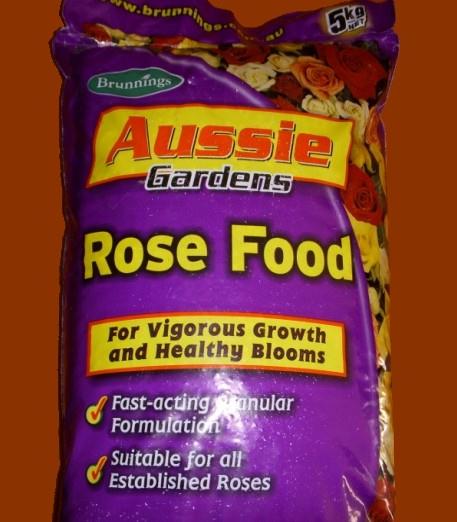

It was initially a matter of trial and error to work out how much to put in each pot because the instructions only gave the quantity to apply on garden beds, but eventually I worked out a dose rate that seems to work OK for me. To save readers the trouble of going through the same time-wasting process I did the dose rates are shown below.
1gm = 3” pot 2.5gm = 4” pot 5gm = 5.5” pot 10gm = 8” pot
I apply this fertilizer when I am re-potting by the following method: I position the plant in the pot and start adding the potting mix until it is about three quarters of the way up the pot; I then sprinkle the required amount of fertilizer around, but not touching the plant. I finish by topping up with the remaining potting mix and give a thorough watering. I find this amount of fertilizer lasts about 3-4 months, after which I alternate between two different foliar fertilizers:
One is called Manutec Bloom Booster (a water soluble pink-coloured powder) and the other is Phostrogen (a white water-soluble powder).
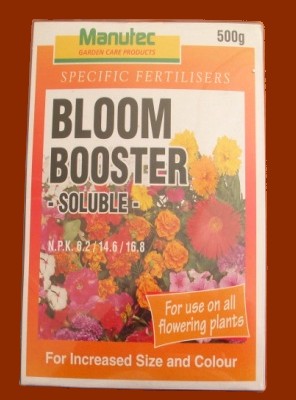

(To apply this I use a very handy little measuring spoon which is supplied with Manutec Bloom Booster fertilizer. One end has a 5gm measure and the other a 1gm measure.)
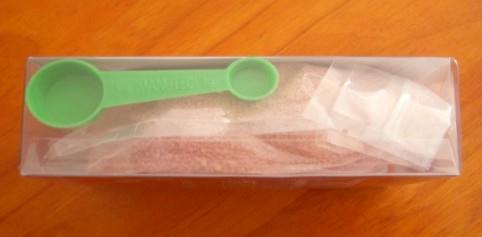
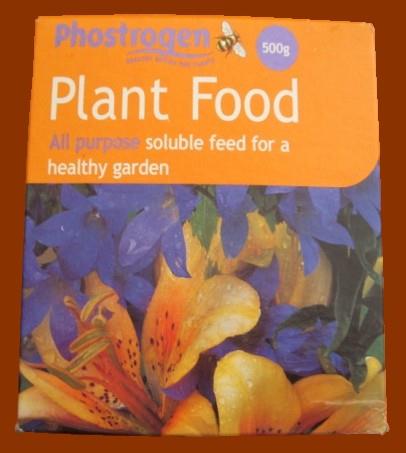
I use both of these fertilizers alternately at monthly intervals using a rate of 1gm per litre of water and apply it to the foliage as well as to the potting mix. (Application is only ever on cloudy days or late afternoon when the sun is no longer on the plants.) In between applications I always give the centre vase of the plant, as well as the whole pot, a thorough flushing out to eliminate the possibility of salt build up.
I have only touched briefly on what I have found with my plants using these “man made” fertilizers and there are numerous growers using many other fertilizers who claim their results to be the best. But in my opinion it gets down to personal choice and what’s best for your plants under your conditions, in your location. Many growers prefer to take a natural approach by using naturally occurring fertilizers; however that is an entirely different topic and can be dealt with at another time.
It would, however, be remiss of me if at this stage if I didn’t clear up a popular myth. I often hear people mention SEASOL and describe it as a fertilizer. It is NOT a fertilizer and can best be described as a “plant tonic”. Although not claimed to be a fertilizer, it does have the following very useful and important benefits to aid healthy plant growth:
• Frost tolerance: It reduces frost damage by lowering the temperature at which plant cells will freeze. This “anti-freeze” effect reduces plant damage during cold spells and hastens the return to productive growth once the temperature improves.
• Heat tolerance: It significantly increases a plant's ability to tolerate excessive heat and is taken up systemically, so it assists the whole plant. It can also aid in the return to productive growth following hot days.
• Drought tolerance: The same mechanism that protects against heat also provides significant protection against drought stress. It can even reverse the effects of dehydration after a single foliar application.
• Disease tolerance: It has been consistently reported that plants treated with it demonstrate reduced incidence and severity of disease.
• Improved plant establishment: It contains naturally occurring plant hormones which stimulate root growth needed for rapid establishment of new plantings and it reduces the effect of transplant shock.
• Improved plant establishment: It contains naturally occurring plant hormones which stimulate root growth needed for rapid establishment of new plantings and it reduces the effect of transplant shock. (I get excellent results by giving my young seedlings a soak in it before I transfer them from community containers to individual pots, and a good watering in with it after they have been potted.)
I use Seasol regularly each month throughout the whole year on my bromeliads and everything else in the garden (even ferns) and I find it does greatly benefit all of my plants.
CORK
(Reprinted from BROMELCAIRNS—2010 #5--the newsletter of the Bromeliad Society of Cairns)
Cork is produced in only 7 Mediterranean countries spread over about 1000 miles: the south of France, Spain, Portugal, Algeria, Corsica and Sardinia. Fifty-two percent of annual production is from Portugal, 32% from Spain and 6% from Italy.
It takes almost 25 years to grow a productive Cork Oak tree, Quercus suber, to a point where it can yield its first commercially useful bark; the first two harvests produce poorer quality cork. The tree then requires a nine year period to regenerate before it can be stripped again.
Cork is stripped in hot summer months when the tree dehydrates and skin becomes loose, then is left in piles for three months to dry out. To improve elasticity and increase flexibility it is boiled in water, to which fungicide has been added. To complete the process it is left to mature in dark cellars for a month. Finally it is trimmed and cut into planks ready for commercial use.
Cork consists of a myriad of 14-sided cells, each of which encapsulates a miniscule amount of air. In one cubic inch of cork there are 200 million of these cells, 50% of which are air. This particular cellular construction makes cork lightweight, buoyant, resistant to moisture and impervious to such things as alcohol, sugar, acids and salts. It is compressible, resilient and chemically inert.
Bottle “corks”: The people of the Roman Empire used cork stoppers to seal barrels of wine. Until the mid-17th century French wine exporters used oil-soaked rags stuffed into bottle necks. They then discovered that wine improved in quality when kept in bottles, and then cork stoppers were used: so began the growth of an industry. Most of the cork industry in Portugal is in the north of the country, near Oporto, the area of the famous Port Wine cellars and the manufacture of stoppers remains the basis of the cork industry in Portugal.
Plastic and screw top stoppers are being used more and more but it has been that cork is best suited for bold red wines purchased with the intent to age.
Cork is used in woodwind musical instruments to fasten together seams, making them airtight; cork is the core of a baseball; used in spacecraft heat shields; inside footwear to improve climate control; floor tiles; fishing floats and buoys; handles for fishing rods. Sheets of cork are the by-product of cork production.
Cork is an excellent mounting medium for bromeliads but in our tropics it is also a popular home for grubs that eat the roots of the plants.
HANDY HINT
(Also from Bromelcairns as referenced above).
• Sugar Soap is a liquid that contains a strong antiseptic.
• Garden tools may be left standing in it and will not rust.
• Sugar Soap may also be used to wash and sterilize pots for reuse.
• It is economical and contains no bleach so saves damage to clothing, etc.
TILLANDSIA WAGNERIANA
A Tribute To A Great Friend. By Lee Moore.

Much has been said and published about Tillandsia wagneriana but few, if any, know the significance of the name or the story behind it. It seems appropriate at this time, 30 years [now over 40—Ed.] after its discovery, to write another tribute to this species and its namesake.
Ronald Thomas Wagner and I had grown up, travelled and planned dreams of adventure together during our high school days of the 1950s. Ronnie was strong and fearless, but gentle and kind-hearted, with the mind of a scholar who loved poetry and Hillbilly music; truly a free spirit and a great and faithful friend. He had faced and fought death many times with almost a charmed life, having been bitten many times by various kinds of poisonous vipers and once losing a finger from the bite of a 6-foot Diamond Back Rattler during one of our treks capturing reptiles in the Florid Everglades for Bill Haast of the Miami Serpentarium. It took a violent plane crash in the northern coastal bush of Colombia to end his life on June 10, 1962. It has been said that he had seen and lived more experiences in his short 23 years than most in a lifetime.
Although Ronnie never had the opportunity to realize his dream of creating a serpentarium for venom extraction in Iquitos, Peru, which would have supplied a great world demand for medical and pharmaceutical research, he will always be remembered by his friends as a dearly loved friend who loved everything and everyone and never had a bad word to say about anyone or anything.
Later in my explorations of the Peruvian jungles, I was to be fortunate to discover one of the most beautiful bromeliads ever to be found: one that would carry a name worthy of the honour to whom it was due—ergo, Tillandsia wagneriana. It was to be the first of many new species of bromeliads and orchids that I would find in the years that followed.
The details of the story that led to the discovery of this plant are only of significance to me but I would like to share an abbreviated account of it again.
During our high school days, while others attended basketball games, dances, drive-in movies and other normal high school activities that kids at that age do, Ronnie and I would be wading around in the deep swamps of the Florida Everglades with a flashlight searching for and capturing Cotton Mouth Moccasins, Rattlers, Coral snakes and Alligators. These were our normal weekend activities, every day and night in the Everglades. It was in the Everglades that I first became interested in orchids and bromeliads which were abundant at that time and were included in our collections.
We used to dream and plan together of one day going to South America where the really important and more interesting things were to be found: he to establish a serpentarium for venom extraction and I to establish a nursery and explore for new and exciting species.
Later on, in 1960, I was introduced to Peru by one of the local tropical fish importers who sent monthly charters to Iquitos on the Amazon River. This was the beginning of the real adventures of which we had dreamed. I had the good fortune to make several trips there in the beginning on the antiquated WWII C-46 cargo plane that he chartered—a 14-hour flight at low altitudes, which now takes only 5 [hours] at very high altitudes, seeing nothing along the way. It was on these trips that I discovered the location of the long-sought-after Aechmea chantinii and several very important orchid species. Later on I would find the Aechmea ‘Pink Goddess’ and many others, including Aechmea mooreana and Neoregelia mooreana, etc.
I introduced Ronnie to Iquitos, who accompanied me on one of these trips, and promptly found an abundance of Fer de Lance (Bothrops), Bushmaster and many other vipers. One of the Bushmasters turned out to be a world record of 12’2” [370.84 cm]. So, it was decided that Iquitos was to be the beginning of our dream and plans for our future enterprises were set in motion; but, as fate would have it, the end of the dream for Ronnie.
During the next year we laid down our plans to establish our projects. We betted, borrowed and stole, so to speak, the needed financing to purchase the equipment for our respective projects and to make the big move towards realizing our dreams of many years. Ronnie had worked with Bill Haast of the Miami Serpentarium, having learned the technology of venom extraction and the freeze-drying process for venom research which was in great demand and highly profitable, but dangerous. He had also learned from Haast the technology of immunization, by administering minute doses of venom to himself over a period of time, creating antibodies, until a full dose, from the dangerous reptiles that he would be handling, would have little effect. So he was prepared. This was not a lark or an adventure, but a very serious undertaking with sophisticated laboratory equipment and knowledge of the subject. I had already established myself in the plant business with the discovery of Aechmea chantinii and several important orchids and had created a successful mail order business. So I, also, was prepared for the big move with assurances of success.
In June of 1962 the big day came. We had chartered an old WWII surplus B-26 bomber, converted for cargo, to carry us and our equipment to our new life and future in the Amazon. It was the only thing that we could afford at the time. But a complication arose in that the FAA would only permit one of us to accompany the flight since, technically, there was only one seat for a passenger, which was an oil can with a seat belt. We were faced with the dilemma of deciding who was going to ride that seat; the other would have to buy passage on a commercial carrier, which in those days to Iquitos was sporadic at best. Jet service had not yet been established, but the decision had to be made. We flipped a coin: Ronnie won the toss. I tried to convince him to trade places with me and I would pay for the commercial ticket down because I was taking my big German shepherd with me and I wanted to care for him along the way. But Ronnie loved ‘Buck’ and assured me that he would be in good hands. So it was settled. I left a few days earlier to make my way to Iquitos via Lima, on to Panagra, then Faucett, to await the arrival of the B-26 with Ronnie, Buck and our cargo.
The night before my departure, I had a dream that a plane had crashed with three occupants: two pilots and a passenger. I could not see faces, but two walked away and the other did not.
I told this to Ronnie and will never forget his forlorn look and half serious but joking response, “Tell me Lee, did I walk away?” But I could not. I was left with an ominous premonition but could not put credence in a dream and neither could he, so we chalked it up as the result of excitement for the trip and it was forgotten…for the moment.
The week passed in Iquitos with no news and communication, in those days, was very difficult. One afternoon as I sat in a local cantina, one of the tropical fish dealers came to look for me with the news that the plane had crashed in Colombia 3 days ago and Ronnie was critical. The two pilots sustained serious injury but had survived. Then I remembered the dream. Had I seen into the future? But how could I have really known?
With the last $500 in my pocket, I made my way back to Lima on the first available flight and then to Barranquilla which was the city closest to where they had gone down. It was not hard to locate Ronnie or the crash because it was still being covered in the local newspapers. I did not speak Spanish at the time, so I hired a translator guide to help me get about in my quest. I found Ronnie in a coma with his legs and arms in casts but the brain concussion was the critical part from which he would never regain consciousness.
Since there was nothing that I could do to help him at the moment, I visited the crash site to see if there was anything that could be salvaged. I knew that Buck would have been killed, but I had to try. When I arrived at the crash site, I saw that salvage was hopeless because anything of any value had already been carried away by the local people but there was no dog. I enquired about a large black and white dog and to my joy and surprise, was told about a big wolf that had come down from the hills about the time of the crash to eat the bodies. They had tried to kill it but he had escaped.
To make a short story of a longer one, I spent the next three days, while Ronnie remained in a coma, searching for Buck. I had, by then, enlightened the locals about the big 'wolf’ and the whole population was scrambling about trying to claim the reward that I had offered. I had seen signs of him everywhere and received daily reports that he was seen here and over there but each time he eluded us out of fear and confusion. On the third day, I decided to camp under a piece of the plane wing hoping that he may return to the only familiar place that he knew there. About 2 am I heard the familiar jingle of his collar tags and called his name. The jingle abruptly stopped. I called again and there he appeared under the moonlight in the swath made by the crashing plane. He crawled to me as if in humiliation thinking that he had been a bad doggie and had done something wrong. It was a tearful and happy reunion. The saga of this search and reunion had become well known and was covered in a big story in the local papers. The story went out over the wires and was picked up by Time Magazine and some of the larger U.S. papers as a human interest story. So Buck became a celebrity.
The next day I was talking to Ronnie as if he could hear me. His father and uncle were present by that time to make whatever arrangements that may become necessary. As I was talking to him, he took one big breath through the tube inserted in his throat and expired. I made a promise to him that I would make sure that he would never be forgotten and his name would live in something of beauty that others would see, appreciate, and remember for as long as it existed.
After arrangements had been made to send Ronnie back to Miami, I was depressed and confused, not knowing what to do. I was out of money and had lost everything but Ronnie had lost more. When I was preparing to leave my hotel and return home, an unusual message was received. The message was from a police station in a small village about 20 miles from the crash site. It said that they may have some items of interest to me after having read about my plight in the newspapers. I went there and found a rickety wooden building with crumbling plaster walls which was the police station. I was shown to a room with a pile of crumpled pieces of the plane wreckage that had been confiscated from the people who had carried it away. My spirit, which had already been broken, fell a little further when I saw a pile of junk which consisted of pieces of twisted aluminium and hydraulic lines from the plane. But then, all of a sudden, underneath it all was a grey metal box: the box that carried the 3x5 index cards with the names and addresses of my customers which was the heart of the mail order business that I had worked for so hard to build and was the reason for my move to Iquitos in the first place. I knew then that I could continue somehow, even though I had lost my friend, my equipment, and my money was exhausted. The box had been bent in the crash so that the two drawers were sealed and the cards were intact. It was a miracle. This was the sign that I needed to continue. Returning to the hotel, there was another message. This one from the airlines offering Buck and myself First Class passage back to Peru for the publicity use of the then famous dog. And so it was, on June 10, 1962, I returned to Iquitos with one suitcase, a box of cards and a celebrated dog. The serpentarium was not to be.
Friends and family pleaded for me to return home, get a job and settle down. I told them that the price that had been paid for this project was already too great to give up and abandon it now. I was determined that the dream would be realized. In the months that followed, I was able to borrow a small amount of money from friends and family to put a small down payment on a piece of land on the Amazon River, with a small wooden house and a dugout canoe with motor. I was able to put together a small shade house with thatched palm fronds which was the beginning of a nursery and began my explorations and collections to supply the mail order business for the next few years until another plane crash that caused me to return home for a while--but that is another story.
During the first months in Iquitos, I had heard about a very remote town in the jungle hills at the base of the Andes called Moyobamba which sounded very interesting. At that time there were no roads to that area and the only way to get there was by a small DC-3 that flew in sporadically about once every week or ten days. When I arrived in Moyobamba for the first time, 3 months after that terrible June of 1962, I fell in love with the place and somehow knew that, someday, this would be the place that I would spend the rest of my life. It was a sleepy little town with dirt streets on top of a plateau nestled in a beautiful valley, with a big sugarloaf mountain called 'The Moro', in low mountain jungle with a pleasant climate; not steamy hot like Iquitos. The houses were all adobe with tile and tin roofs with orchids and bromeliads growing everywhere--right on the clay tiles and covering the fruit trees in the yards.
Little did I know at the time, that this would become the place of many new and exciting discoveries for me in the future.
I was the first to ever go there looking for orchids and bromeliads. Since then, the town has been destroyed twice by earthquakes and rebuilt so it has greatly changed from what it was. Today there are roads and daily jet service to that area. I live there today with 57 acres to develop into a nursery. Moyobamba will be the subject of many adventure stories in the future.
During those first two weeks that I spent there walking out into the jungle in different directions each day, one day was very special. I came across a little patch of cleared land with a small thatched house where a little old man did his farming. The old wrinkled man was squatting by a pot of boiling sugar cane juice which he offered to me to sip from a gourd ladle. Among the pineapples around his hut, a branched pink inflorescence caught my eye. Apparently the pink colour pleased the old man since he had planted this epiphyte in the ground to adorn his yard. I recognized this to be a tillandsia like none other that I had ever seen before. The old man pointed to a far ridge toward the north explaining that it was a day's journey to where they are found.
I spent the night with the old man, in anticipation of our journey the next day, and thought of this new tillandsia which I was sure would be a new species. Few would ever hear of my friend Ronnie Wagner and the great things that he would have done, but this bromeliad could be a memorial to him for as long as the horticultural world cherished it. At that moment, only I knew of this outstanding new bromeliad that was to be presented to the bromeliad world and no one would ever know, like I, the fantastic story behind it----Tillandsia wagneriana, 'In Memory of a Great Friend'.
At this point, I must make a confession. When I made my first important discoveries, such as Aechmea chantinii and a number of other orchids and bromeliads, I innocently and dutifully reported exactly where I had found them. Immediately, others flocked behind me to cash in on my hard work of literally blood, sweat and tears, which cost them nothing. I learned quickly to covet my future discoveries for a while so that others would not go behind me so easily after I had made all of the effort to find them. So I purposely reported that I had found T. wagneriana in the vicinity of Iquitos where I was living at the time. Surely enough, they came looking but did not find; because it really only comes from a very small micro-zone near Moyobamba 800 miles away from Iquitos and only I knew where it was. This information will have to be changed now. Now that it is in cultivation, I have since taken many collectors to this area.
I am proud to make this tribute to my friend, Ronald Wagner.
After a delicious dessert of fresh pineapple, the Killingleys were suddenly confronted by an uprising of their normally docile bromeliads..........................................
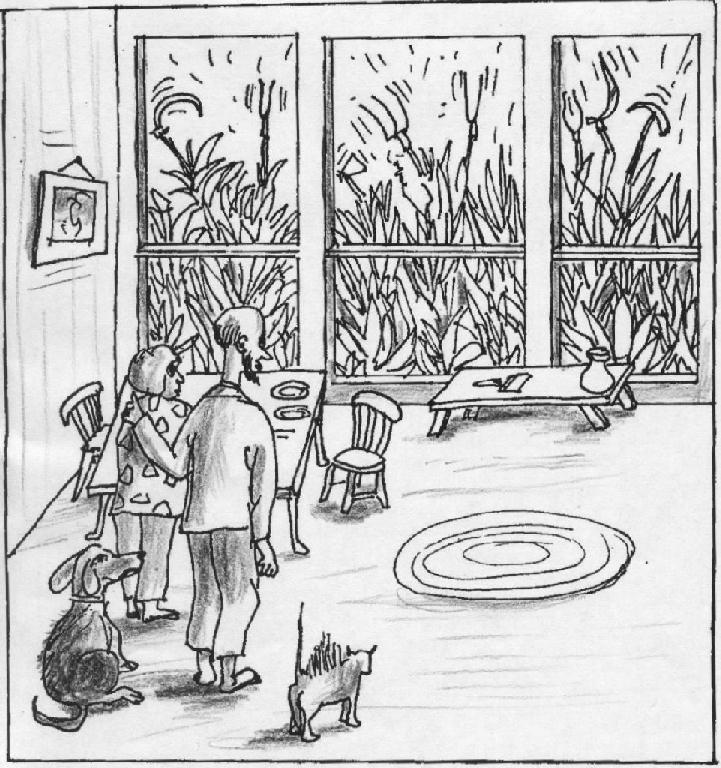
Located at REPTON, south of COFFS HARBOUR
SPECIES AND VARIEGATES Beautiful TILLANDSIAS, VRIESEAS, NEOREGELIAS, AECHMEAS, ETC.
Visitors welcome but phone first: |
Ross Little and Helen Clewett 114 Pine Street, WARDELL P.O. Box 385, WARDELL, 2477 Phone/Fax: (02) 6683 4188 pinegrovebromeliads@bigpond.com AECHMEAS, ALCANTAREAS, GUZMANIAS, VRIESEAS, TILLANDSIAS, NEOREGELIAS AND MORE Open 7 days - Visitors welcome but please phone first. |
The Cheapest Bromeliads on the Internet! Cradle Nursery is a small wholesale nursery on the NSW far south coast, currently selling via their website and on eBay, as well as at the local markets in the area: - Moruya Market - Every Saturday - Candelo Market - 1st Sunday - Pambula Market - 2nd Sunday - Batemans Bay Market - 3rd Sunday - Bermagui Market - Last Sunday Tim and Ernie Berger - Phone: 04 4758 7618 Email: sales@cradlenursery.com.au Website: www.cradlenursery.com.au |
The new Judging School will commence in February 2011. If you are interested in joining this group please contact Eileen Phone: (02) 9544 4726/Email: stagra7@ozemail.com.au |
Darwin NT - 7th – 10th April 2011 Registration: $280 1/11/10 to 6/4/11. Thereafter $300 Venue: Holiday Inn ‘Esplanade’ – 116 The Esplanade, Darwin, NT There will be garden tours and plant competition Contacts: Registrar: Ross broms16@bigpond.com Information: Harry acacia@octo4.net.au |